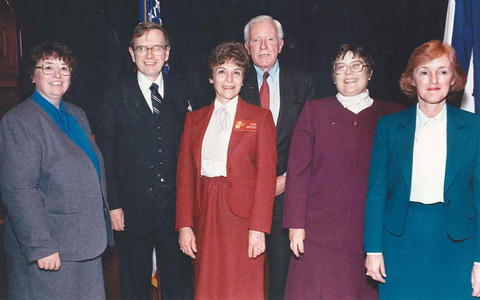Baldrige Spreads to the States

In the fall of 1987, Reimann said he received a visit from Connecticut resident Sheila Carmine who thought it would be interesting to launch a parallel award in Connecticut because Malcolm Baldrige had served as CEO of a major Connecticut manufacturer. Reimann said he encouraged Carmine and tried to be as helpful as possible. This meeting was the first of scores of visits from organizations in the United States and around the world that wanted to create similar awards. Reimann said he felt the “purpose [of Baldrige] was 99% to promote awareness and sharing,” and new networks of Baldrige users supported this purpose; “We have always regarded the state programs as our partners in a larger campaign....... Together, with the states, our reach is much greater than it would have been without them.”
In 1992, Bob Chapman, the Baldrige Program’s information and outreach leader, led a study commissioned by the National Governors’ Association that led to the report Promoting Quality Businesses: A State Action Agenda. The report outlined ways that governors could use public/private resources to accelerate quality practices and design and implement a state quality award. Reimann said the commission’s recommendations gave the staff the encouragement to promote the idea that Baldrige‐based programs across the United States had merit.
Many states already had a U.S. Senate Productivity Award given by U.S. Senators to the companies in their states with exemplary quality and productivity improvement efforts, an award established through a Senate Resolution in 1982. With the encouragement of the National Governors’ Association, many states merged the two and became Baldrige‐based while retaining components of the productivity award. Chapman worked with interested state programs to coordinate efforts, organizing the first State and Local Quality Award Workshops.
In 2005, Baldrige‐based state, local, and sector programs merged to create the Alliance for Performance Excellence as a way to better coordinate resources and initiatives. “State and local Baldrige‐based programs play a key role in facilitating performance excellence in the U.S.,” said Brian Lassiter, chair of the Alliance for Performance Excellence and president of the Performance Excellence Network (the Minnesota state program, founded in 1987, about the same time that the national program was created). “Today, state and local programs create somewhat of a ‘feeder system’ for the national award, preparing both applicants and volunteer examiners to serve in the national program. But state programs also serve the broader role of educating, coaching, and facilitating continuous improvement with literally thousands of organizations across the country. Over the last 10 years or so, three out of every four national award recipients have first received their top state award, indicating the vital role that state programs play in helping organizations start, accelerate, and sustain a journey towards excellence.”
Contacts
-
Baldrige Customer Service(301) 975-2036NIST/BPEP
100 Bureau Drive, M/S 1020
Gaithersburg, MD 20899-1020

